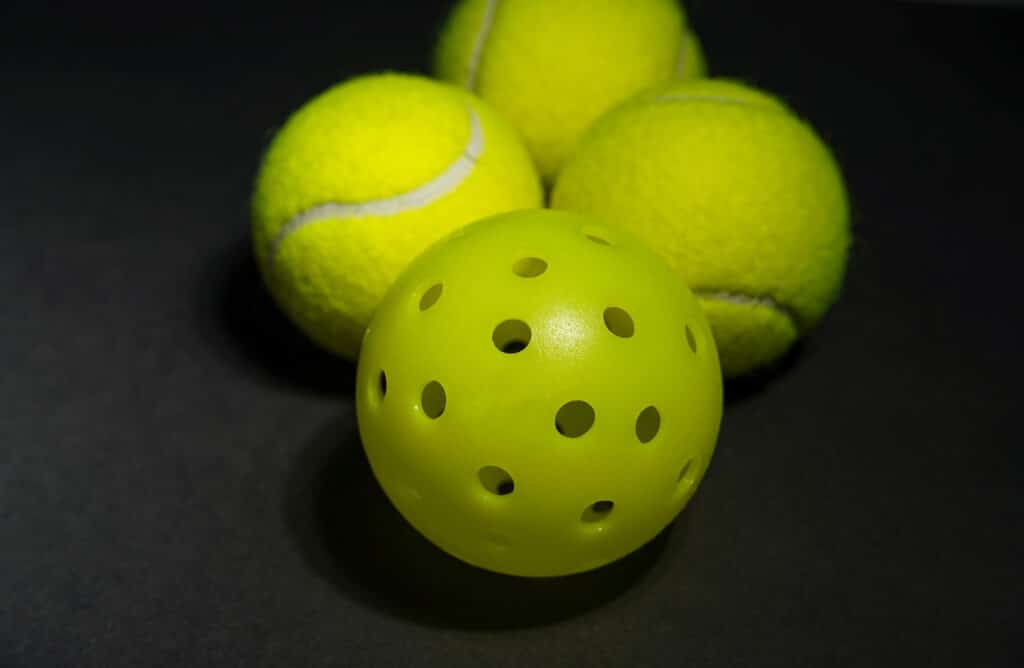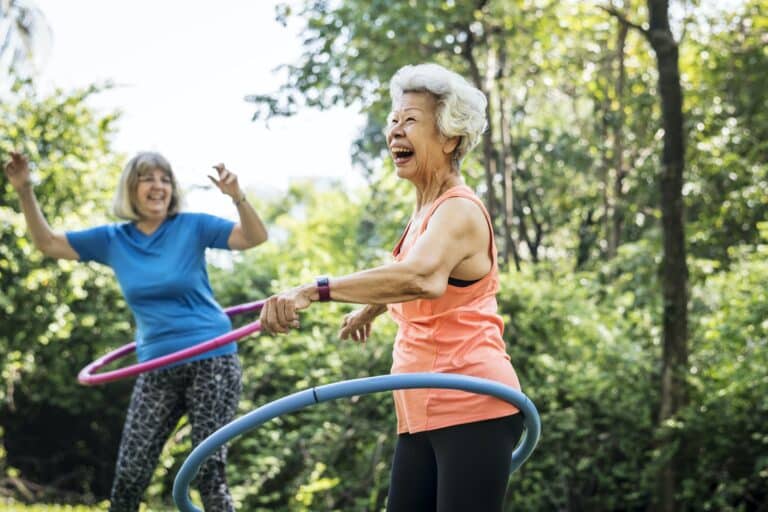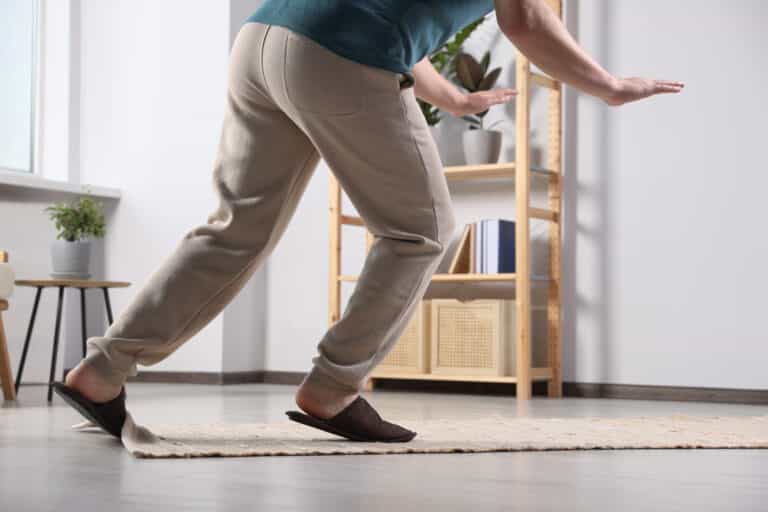Are you curious about the difference between pickleball vs. tennis? The rapidly growing sport of pickleball has piqued the interest of many people, including tennis enthusiasts.
While both sports share a handful of characteristics, such as using racquets and a ball, they pose different physical demands, health benefits, accessibility, and social dynamics.
In short, they’re similar but different activities.
Tennis tends to be more physically demanding and requires a higher competitive skill level. Pickleball is often considered more casual and fosters community engagement and friendship in place of intense competition.
Tennis has a traditional, nostalgic appeal. Pickleball is more generally accessible, inclusive, and affordable.
This article delves into the nuances of pickleball and tennis, highlighting their distinctive attributes and shedding light on why individuals gravitate towards one over the other.
Pickleball vs. Tennis: Instructional Differences
The rules of the two sports display some apparent differences. Here are a couple of ways in which they differ.
Serving Style
First, if you were reviewing the instruction manuals for both sports, you’d encounter fundamental differences in serving techniques.
Pickleball rules require an underhand serve, a maneuver characterized by its simplicity and accessibility.
In contrast, tennis employs the overhand serve, a more intricate motion demanding precision and technique.
The Two-Bounce Rule
Pickleball introduces a unique rule known as the two-bounce rule, which adds an extra layer of strategy to the game.
According to this rule, during both the serve and the return, each team must allow the ball to bounce once on their side of the court before volleying it over the net (i.e., hitting it before it bounces).
After these first two hits, a bounce is no longer required. Additionally, pickleball designates a non-volley zone, also known as the “kitchen,” where players are prohibited from volleying the ball, preventing aggressive net play.
Under tennis rules, the ball does not need to hit the ground, and aggressive volleys are common.
Differences in Scoring
Scoring systems also differ significantly between pickleball and tennis.
Pickleball employs a straightforward scoring method. Only the serving team can earn points. Scoring goes to eleven points, with the winning team needing to win by two.
Tennis uses a unique scoring system comprising points scored as 0, 15, 30, and 40, culminating in sets and matches. Tennis scoring is often more complicated for beginners to follow.
Court Dimensions and Layout
The courts for both games are also different in meaningful ways.
Pickleball courts, characterized by their compact size, measure 44 feet in length and 20 feet in width, offering a more intimate playing experience.
In contrast, tennis courts boast larger dimensions, spanning 78 feet in length for doubles matches and 36 feet in width.
Net heights also differ for the two sports, with pickleball nets standing 34 inches in the center compared to tennis nets, which reach 42 inches at the posts. These variations require players to use different techniques and abilities.
These technical differences make gameplay feel different for both sports, which can result in different physical demands from the players. Let’s take a look at the physical side of both activities.
Physical Demands
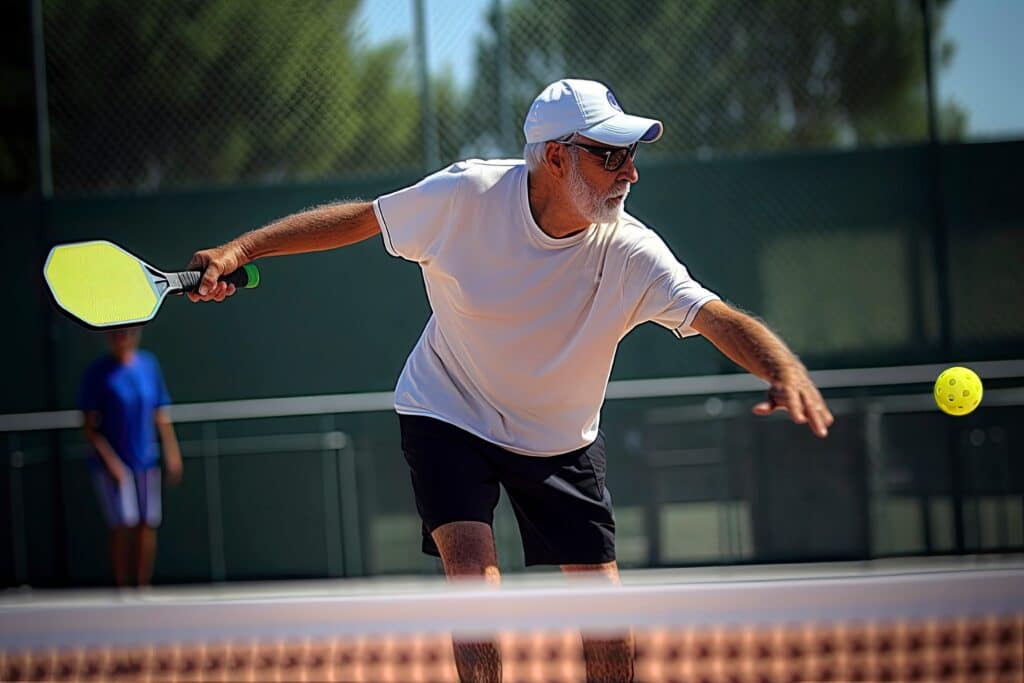
While neither activity is easy, examining the particular physical demands of the sport might help you determine which one is right for you.
Pickleball: A Fun Way to Stay Active With Friends
Pickleball provides a welcoming environment for individuals of all ages and fitness levels due to its accessibility.
The sport offers a lower-impact alternative to tennis, making it particularly appealing to those seeking a gentler exercise option. The smaller court size and lighter equipment inherent to pickleball reduce strain on joints, mitigating the risk of injury and enabling individuals with mobility limitations to participate comfortably.
Pickleball’s emphasis on agility, quick reflexes, and strategic shot placement distinguishes it from tennis. Players must employ finesse and precision rather than relying on big, powerful movements.
These more technical movements require mental acuity and tactical thinking but less physical exertion. This strategic approach enhances gameplay enjoyment and improves cardiovascular health and muscular endurance.
Whether playing casual matches or competitive tournaments, pickleball players experience the benefits of aerobic exercise without overexerting themselves. It is an accessible and enjoyable option for individuals seeking to improve their fitness levels while minimizing physical strain.
Pickleball is also highly social, with casual and competitive leagues in many communities.
Tennis: A Challenging, Time-Honored Competitive Sport
In contrast, tennis is renowned for its demanding physicality and athletic prowess. The sport requires greater endurance, strength, and speed to effectively navigate the larger court dimensions and wield heavier racquets.
Tennis players engage in prolonged matches characterized by intense rallies, demanding peak physical performance and mental resilience.1
The dynamic nature of tennis necessitates extensive movement and quick reflexes, challenging players to adapt to changing game conditions and opponents’ strategies. From explosive serves to lightning-fast volleys, tennis demands high athleticism and coordination.
The intense nature of tennis matches improves cardiovascular fitness and overall endurance. Whether competing at a recreational level or pursuing professional aspirations, tennis players benefit from the physical and mental rewards of sustained training and competition.
However, both sports are competitive and offer personal growth and athletic achievement. They encourage teamwork, individual development, a love of sport, and active living.
Health Benefits
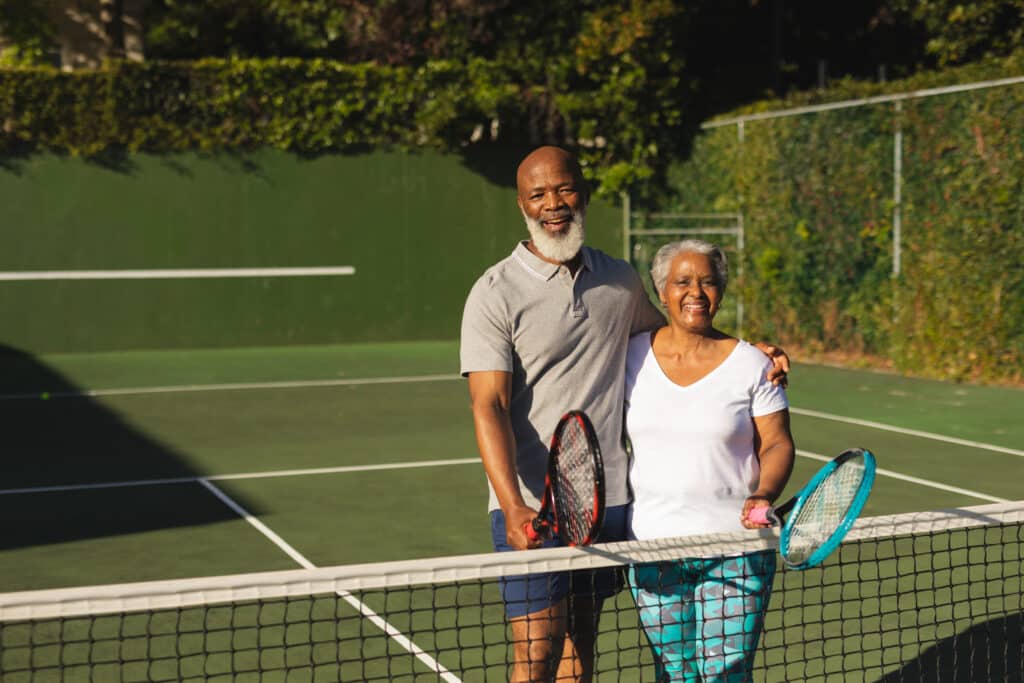
Both tennis and pickleball engage multiple muscle groups in the legs, arms, core, and back. Swinging the racquet, running, and lunging help to build muscle strength and endurance, leading to toned muscles and increased overall fitness.
Weight Management and Cardiovascular Health
Regular participation in either tennis or pickleball can contribute to weight management and improve body composition over time.
Due to the requirement of constant movement, a match in either sport can reliably help you maintain a consistent caloric burn beyond, say, a brisk walk, which requires less full-body effort.
Tennis is an excellent high-intensity aerobic exercise that gets the heart pumping and improves cardiovascular health.
The combination of short bursts of intense activity, such as sprinting to reach the ball, and periods of lower-intensity movement, like walking or jogging between points, strengthens the heart and improves circulation.
Pickleball is more of a low-impact, moderate-intensity game while still challenging and improving cardiac fitness.
Strength, Bone Health and Agility
The weight-bearing nature of pickleball and tennis, particularly on hard courts, can help improve bone density and reduce the risk of osteoporosis later in life.
The impact of running, jumping, and pivoting stimulates bone growth and strengthens the skeletal system, promoting long-term bone health.
However, tennis’s intensity may deter beginners or those seeking more leisurely exercise. Pickleball’s moderate intensity may also be more appealing and accessible for individuals recovering from injuries or managing chronic conditions.
Social Dynamics and Community Engagement
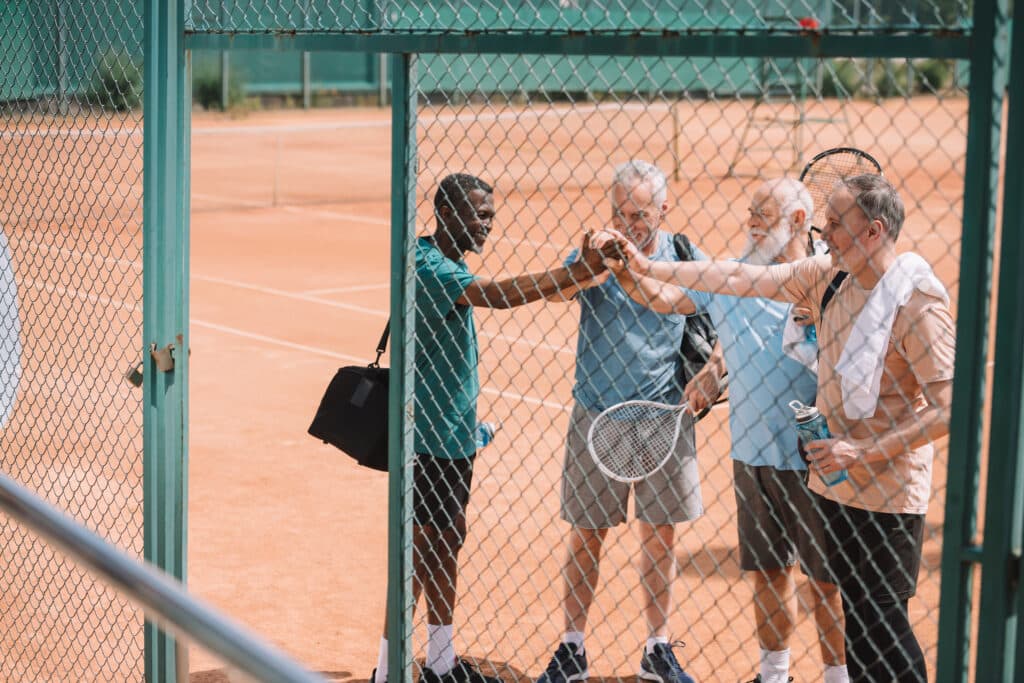
The inclusive nature of pickleball encourages participation from diverse age groups and skill levels, creating a welcoming environment for newcomers and bonds beyond the court. Whether a seasoned athlete or a newcomer, you have a place on the pickleball court.
Many local pickleball communities organize regular events, such as tournaments, round-robin play, and social mixers, to unite players and strengthen community ties.
These events provide opportunities for players to connect, compete, and celebrate their shared passion for the sport. They may strengthen relationships among players and promote active lifestyles, which is especially important among the older adult population.2
How Tennis Stacks Up As A Social Activity
Tennis also offers opportunities for social interaction and community engagement, though its traditional image and perceived barriers to entry may limit inclusivity.
Tennis clubs and facilities are hubs of activity and social interaction, bringing together players of all ages and skill levels.
Whether it’s a bustling weekend tournament or a leisurely afternoon match, tennis clubs offer their members a sense of belonging and companionship. Players forge friendships and build connections with fellow enthusiasts, creating a supportive community beyond the court.
Many tennis clubs participate in interclub competitions and leagues, allowing players to represent their clubs and compete against neighboring communities. These events promote a sense of pride and togetherness among club members, who come together to support their team and celebrate collective achievements.
Tennis clubs and facilities may cater primarily to experienced players or affluent individuals, potentially alienating newcomers or those seeking a more casual recreational experience. However, tennis remains a beloved pastime for enthusiasts who appreciate its competitive spirit and rich history.
Tennis for Youth
Tennis clubs often offer junior programs and clinics to develop young talent and foster a love for the sport from an early age.
These programs allow children to learn new skills, build confidence, and form lasting friendships with their peers. Tennis becomes not just a sport but a community that nurtures and supports its youngest members as they grow and develop.4
Both pickleball and tennis serve as catalysts for community building, providing opportunities for social interaction, friendly competition, and shared experiences.
Whether it’s the inclusive atmosphere of a pickleball match or the camaraderie of a tennis club, these sports bring people together and create lasting bonds that enrich lives both on and off the court.
Whether playing casually with friends or competing in organized leagues and tournaments, these sports nurture connections and friendships that contribute to overall mental health and happiness.
Equipment and Accessibility

Regarding these two sports, equipment differences go deeper than using different types of balls.
Another distinguishing factor between pickleball and tennis is the cost and accessibility of equipment.
Pickleball equipment, including paddles and balls, is often more affordable and portable than tennis gear. This affordability makes pickleball accessible to a broader audience, particularly those hesitant to invest in expensive equipment or memberships.
Additionally, the lightweight nature of pickleball equipment allows for easy transportation and storage, accommodating players with limited space or resources.
In contrast, tennis equipment, such as racquets, balls, and attire, can be more costly and cumbersome. The need for specialized equipment and court access may present financial barriers for individuals considering tennis as a recreational pursuit.
Tennis courts may also be associated with private clubs or public facilities that require membership fees or court reservations. These may be barriers for casual players or beginners, but many parks and community recreational facilities offer free or low-cost tennis programs and court access.
Both sports require essential items such as racquets/paddles, balls, shoes, and apparel. However, pickleball equipment typically costs less due to the smaller court size and fewer specialized items needed.
Individual preferences, brand choices, and quality considerations can significantly impact the total equipment cost for both sports.
Pickleball vs. Tennis: A Community Perspective
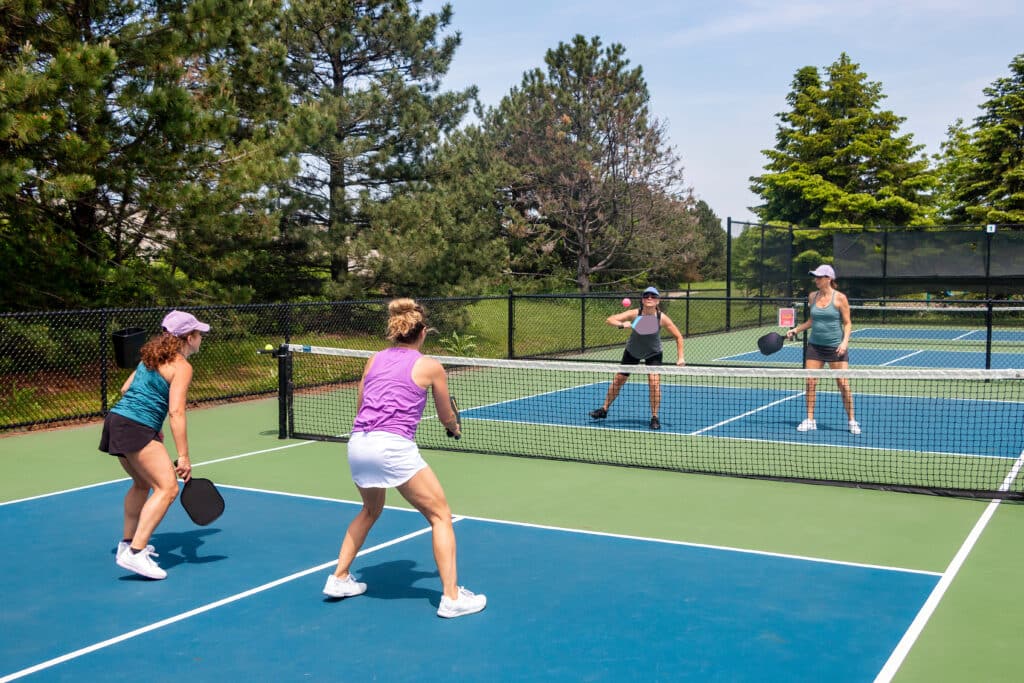
Like many other components of these two sports, community perceptions might differ. Here are two perspectives.
Tennis: A Classic, Fun—But Sometimes Exclusive Community Activity
For many long-time residents of close-knit communities, tennis holds a cherished place in community culture.
It evokes nostalgia for summer afternoons spent on the court. Established tennis clubs and facilities serve as gathering spots for enthusiasts, fostering a sense of friendship and tradition. Longtime residents often view tennis as a timeless pastime that symbolizes grace, elegance, and sportsmanship.
However, some residents express concerns about tennis’s perceived exclusivity, particularly in affluent neighborhoods where private clubs dominate the landscape.
Membership fees, dress codes, and court reservations may deter individuals from diverse socioeconomic backgrounds, creating barriers to participation. As a result, tennis clubs may feel detached from the broader community.4
Pickleball: An Accessible, Modern Communal Sport
Pickleball represents a more modern phenomenon, capturing the imagination of community members with its accessible, inclusive appeal.
As pickleball courts appear in parks and recreational centers, communities embrace the sport as a recreational revitalization and innovation symbol.
Beginners and seasoned players alike are drawn to pickleball’s laid-back atmosphere and social interaction, enjoying both friendly matches and impromptu tournaments.
One of Pickleball’s greatest strengths is its ability to unite individuals of all backgrounds and demographics, transcending generational divides. Families, retirees, and young professionals converge on pickleball courts, forming connections and friendships through this activity.
The sport’s adaptable pace and forgiving rules make it accessible to newcomers, creating a welcoming environment for players from diverse walks of life. It also plays a role in transforming underutilized spaces into vibrant hubs of activity.
Local governments and grassroots organizations embrace pickleball as a tool for social cohesion and urban renewal, investing in court infrastructure and programming to meet growing demand.
Pickleball advocates hope to cultivate residents’ sense of belonging and civic pride by prioritizing public access and inclusivity.
While tennis remains an emblem of tradition and prestige for some, others gravitate towards pickleball’s accessibility and sociability. Communities can embrace both sports as integral components of a vibrant and inclusive recreational landscape.
Summary
Pickleball and tennis offer distinct experiences with varying physical, health, and social implications and pros and cons for either sport. While pickleball excels in accessibility, inclusivity, and affordability, tennis boasts a rich tradition, competitive intensity, and physical rigor. Whether one chooses pickleball for its friendly atmosphere, minimal barriers to entry, and low-impact exercise or tennis for its athleticism and competitive zeal, both sports contribute to a vibrant and active lifestyle. Ultimately, pickleball and tennis reflect individual preferences, priorities, and physical and mental well-being aspirations.
Key Takeaways
- Pickleball and tennis are racquet sports with distinct characteristics, rules, and gameplay styles.
- Tennis is more physically demanding and requires a higher competitive skill level, while pickleball is typically more casual and accessible.
- The physical demands of pickleball are less strenuous, making it a more accessible form of exercise for individuals of all ages and fitness levels.
- Tennis requires greater endurance, strength, and speed, demanding peak physical performance and mental resilience.
- Both sports offer health benefits such as muscle strength and endurance, weight management, cardiovascular health, bone health, and improved agility.
- Pickleball is known for its inclusivity, fostering community engagement and friendship, while tennis clubs often offer their members a sense of belonging and companionship.
- The cost and accessibility of equipment is another distinguishing factor, with pickleball gear being generally more affordable and portable than tennis gear.
- Communities can embrace both sports as integral components of a vibrant and inclusive recreational landscape, with pickleball seen as a modern, accessible sport and tennis as a traditional, prestigious activity.
- The choice between pickleball and tennis reflects individual preferences, priorities, and physical and mental well-being aspirations.
References
- Pluim, B. M., Staal, J. B., Marks, B. L., Miller, S., & Miley, D. (2007). Health benefits of tennis. British journal of sports medicine, 41(11), 760-768.
- Buzzelli, A. A., & Draper, J. A. (2019). Examining the motivation and perceived benefits of pickleball participation in older adults. Journal of Aging and Physical Activity, 28(2), 180-186.
- Cerezuela, J. L., Lirola, M. J., & Cangas, A. J. (2023). Pickleball and mental health in adults: A systematic review. Frontiers in Psychology, 14, 1137047.
- STRATEGIESFORSUCCESSF, U. (2016). The Next Generation of the Club Community. Pulse, 9(12), 23.

